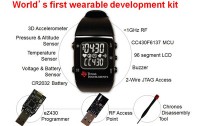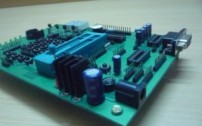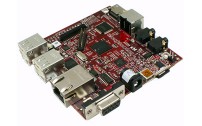Developer Kits

SBCs, Developer Kits & Trainer kits for Embedded Systems, DSP and Robotics related applications. Various kits available for PIC 16, PIC 18, dsPIC, ARM Processors, Robotics, Automation etc

SBCs, Developer Kits & Trainer kits for Embedded Systems, DSP and Robotics related applications. Various kits available for PIC 16, PIC 18, dsPIC, ARM Processors, Robotics, Automation etc

The Microstick for dsPIC33F and PIC24H devices is designed to provide designers with an easy to use, economical development environment for 16-bit dsPIC® Digital Signal Controllers and PIC® Microcontrollers.
Microstick provides all you need to get started at a very low cost. It has an integrated programmer / debugger. It can be used stand-alone or plugged into a prototyping board for extremely flexible development. The device under test is socketed for easy change-out, and Microchip’s MPLAB® Integrated Development Environment supports Microstick. It has never been more affordable to get started with Microchip 16-bit devices!
Key Features:

The eZ430-Chronos is a highly integrated, wearable wireless development system based for the CC430 in a sports watch. It may be used as a reference platform for watch systems, a personal display for personal area networks, or as a wireless sensor node for remote data collection.
Based on the CC430F6137 <1 GHz RF SoC, the eZ430-Chronos is a complete CC430-based development system contained in a watch. This tool features a 96 segment LCD display and provides an integrated pressure sensor and 3-axis accelerometer for motion sensitive control. The integrated wireless feature allows the Chronos to act as a central hub for nearby wireless sensors such as pedometers and heart rate monitors. The eZ430-Chronos offers temperature and battery voltage measurement and is complete with a USB-based CC1111 wireless interface to a PC.
The eZ430-Chronos watch may be disassembled to be reprogrammed with a custom application and includes an eZ430 USB programming interface.

Microchip’s PICkit 3 In-Circuit Debugger/Programmer uses in-circuit debugging logic incorporated into each chip with Flash memory to provide a low-cost hardware debugger and programmer. In-circuit debugging offers these benefits:
The PICkit 3 can now also reprogram any PIC microcontroller with a simple push of a button:
The MPLAB PICkit 3 allows debugging and programming of PIC® and dsPIC® Flash microcontrollers at a most affordable price point, using the powerful graphical user interface of the MPLAB X Integrated Development Environment (IDE) and the MPLAB X IPE that is installed with it. The MPLAB PICkit 3 is connected to the design engineer’s PC using a full speed USB interface and can be connected to the target via an Microchip debug (RJ-11) connector (compatible with MPLAB ICD 2, MPLAB ICD 3 and MPLAB REAL ICE). The connector uses two device I/O pins and the reset line to implement in-circuit debugging and In-Circuit Serial Programming™.
PICkit 3 Features

The Arduino Uno is a microcontroller board based on the ATmega328 (datasheet). It has 14 digital input/output pins (of which 6 can be used as PWM outputs), 6 analog inputs, a 16 MHz ceramic resonator, a USB connection, a power jack, an ICSP header, and a reset button. It contains everything needed to support the microcontroller; simply connect it to a computer with a USB cable or power it with a AC-to-DC adapter or battery to get started.
The Uno differs from all preceding boards in that it does not use the FTDI USB-to-serial driver chip. Instead, it features the Atmega16U2 (Atmega8U2 up to version R2) programmed as a USB-to-serial converter.
Technical Specification
| Microcontroller | ATmega328 |
| Operating Voltage | 5V |
| Input Voltage (recommended) | 7-12V |
| Input Voltage (limits) | 6-20V |
| Digital I/O Pins | 14 (of which 6 provide PWM output) |
| Analog Input Pins | 6 |
| DC Current per I/O Pin | 40 mA |
| DC Current for 3.3V Pin | 50 mA |
| Flash Memory | 32 KB (ATmega328) of which 0.5 KB used by bootloader |
| SRAM | 2 KB (ATmega328) |
| EEPROM | 1 KB (ATmega328) |
| Clock Speed | 16 MHz |

The Raspberry Pi is a credit-card-sized single-board computer developed in the UK by the Raspberry Pi Foundation with the intention of promoting the teaching of basic computer science in schools

Technical Specification

Product Description
The Beagle Board is an incredibly powerful single-board computer developed by Texas Instruments, featuring their OMAP3530 system on a chip. The board is supported by a large community and is designed with open-source development in mind.
The BeagleBoard-xM delivers with the help of its AM37x 1GHz ARM processor, enabling hobbyists, students and innovators to bring a project to development fast. Designed with community inputs in mind, this open hardware design brings the previous generations’ laptop-like performance and expandability to the next level, while adhering to hand-held power levels. Direct connectivity is supported by the on-board four-port hub with 10/100 Ethernet, while maintaining a tiny credit-card-sized footprint.
Technical Specification
Copyright 2013 Grey TechnolabsAll Rights Reserved RSS Student Resources Moodle Sitemap Employee Login Jobs Downloads |
Back to the top